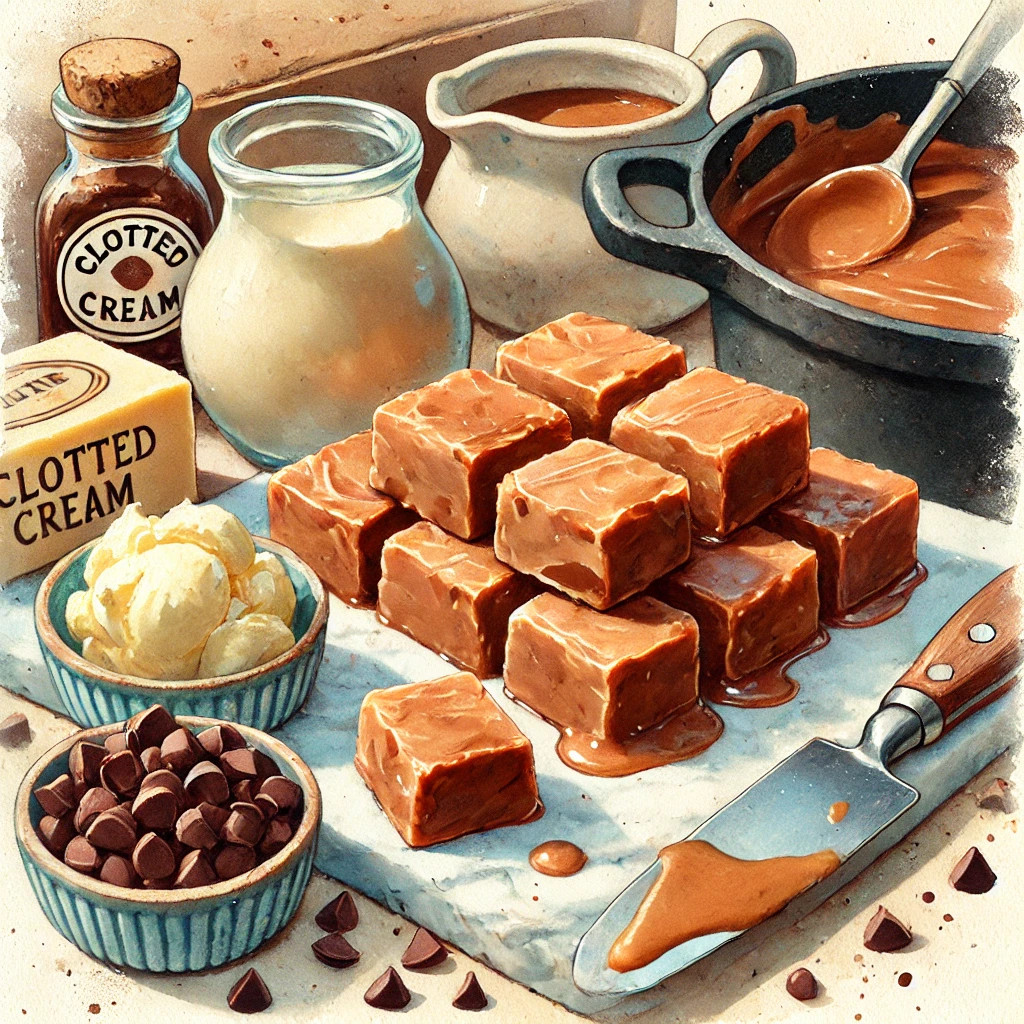 2.jpg) Fudge, with its creamy, melt-in-the-mouth texture, has been a beloved treat for generations. But where exactly did this delicious confection come from?
Fudge, with its creamy, melt-in-the-mouth texture, has been a beloved treat for generations. But where exactly did this delicious confection come from?
Although fudge might seem simple, its origins are surprisingly rich and complex, spanning continents and cultures.
Let’s explore the fascinating history of fudge, from its accidental beginnings in American kitchens to its status as a favourite sweet treat in the UK—and discover how Cornish fudge became one of the most iconic varieties.
The Early History of Fudge: From Fondant to Fudge
The story of fudge begins in the 18th century with a confection known as *fondant*. Fondant was a popular smooth sugar paste in France, created by master confectioners who were highly skilled in sugar work. While fondant was primarily used to coat cakes and pastries, its silky texture laid the groundwork for what would later become fudge.
In the 19th century, both American and European candy-making traditions began evolving rapidly. With greater access to sugar and butter, home cooks in the United States started experimenting with new sugary confections. It’s believed that fudge was created by accident when a caramel or toffee recipe didn’t quite go as planned. Instead of producing a hard candy, confectioners ended up with a softer, velvety sweet treat that became known as fudge.
Fudge Origins: How Baltimore Put Fudge on the Map
Fudge owes much of its fame to Baltimore, Maryland, where it’s said the first known batch was made in **1886**. According to local legend, a young woman accidentally “fudged” her caramel while experimenting in the kitchen. Instead of discarding the mixture, she tasted it and realised she had stumbled upon a new kind of candy. Word spread quickly, and soon, Baltimore became known for its fudge—a simple recipe made with sugar, butter, and milk that home cooks across America could easily replicate.
Fudge’s Rise to Popularity: From Homemade Treat to Cookbook Star
As fudge’s popularity grew in the late 19th century, it started appearing in popular American cookbooks. Fannie Farmer’s Boston Cooking-School Cook Book, first published in 1896, included one of the earliest printed recipes for fudge, helping cement its place in American homes.
Chocolate was soon added to the mix, making chocolate fudge the most popular variety, although caramel fudge remained a favourite in some regions.
By the early 20th century, fudge had become a staple at fairs, seaside resorts, and tourist destinations like Mackinac Island, Michigan. The island became famous for its fudge shops, where tourists could watch confectioners prepare fudge on marble slabs—a technique that’s still used today to cool the fudge quickly. Mackinac Island’s reputation for fudge grew so strong that it became known as the "Fudge Capital of the World."
Fudge Comes to the UK: British Fudge vs. American Fudge
While fudge may have found its origins in the United States, it didn’t take long for the sweet treat to make its way across the Atlantic. British fudge, which gained popularity in the early 20th century, differs slightly from American fudge. It’s typically less sweet and has a firmer, more crumbly texture, making it a cross between American fudge and Scottish *tablet*, a grainy confection made with sugar, butter, and condensed milk.
One of the most beloved varieties in the UK is Cornish Cream Fudge, renowned for its smooth texture and rich flavour, thanks to the use of Cornish clotted cream. The dairy heritage of Cornwall adds a unique twist to traditional fudge recipes, with local fudge shops continuing to use traditional methods to boil sugar, butter, and cream. Cornish fudge has become a must-try for visitors, with its velvety texture making it a hit among tourists and locals alike.
 One of my fondest memories of fudge comes from a visit to Cornwall, where I was leading a chocolate masterclass at a local hotel. After the class, I stopped by a traditional Cornish fudge shop. Watching the confectioners work their magic, pouring fudge onto marble slabs to cool, the rich scent of caramelised sugar and butter filled the air. What made it special was the addition of **Cornish clotted cream**, which gave the fudge an extra layer of indulgence. It’s moments like this that remind me how fudge, though simple in ingredients, captures the essence of local traditions—whether it’s at a seaside town in the UK or a boardwalk in the United States.
One of my fondest memories of fudge comes from a visit to Cornwall, where I was leading a chocolate masterclass at a local hotel. After the class, I stopped by a traditional Cornish fudge shop. Watching the confectioners work their magic, pouring fudge onto marble slabs to cool, the rich scent of caramelised sugar and butter filled the air. What made it special was the addition of **Cornish clotted cream**, which gave the fudge an extra layer of indulgence. It’s moments like this that remind me how fudge, though simple in ingredients, captures the essence of local traditions—whether it’s at a seaside town in the UK or a boardwalk in the United States.
Fudge in the Modern World: Endless Varieties and Global Appeal
Today, fudge is enjoyed all over the world, with countless variations available. From classic chocolate fudge and caramel fudge to more adventurous flavours like salted caramel and chilli chocolate, fudge has evolved into a versatile confection. Even vegan fudge made with plant-based ingredients is gaining popularity, proving that fudge continues to adapt to modern tastes.
In the UK, fudge is a staple at seaside towns, county fairs, and holiday destinations, similar to its role in the United States. Whether it’s the crumbly, firm British fudge or the smoother American version, there’s no doubt that this sweet treat has universal appeal.
How to Make Quick & Easy Microwave Fudge
Now that you’ve learned the history of fudge, why not try making your own? This microwave fudge recipe is quick and simple, perfect for when you’re craving something sweet.
Ingredients:
400g sweetened condensed milk
300g dark or milk chocolate (chopped or chocolate chips)
50g unsalted butter
1 tsp vanilla extract
A pinch of salt (optional)
Optional mix-ins: nuts, dried fruit, or caramel chunks
Method:
1. Grease a 20cm square baking dish and line with parchment paper, leaving an overhang for easy removal.
2. In a microwave-safe bowl, combine the condensed milk, chopped chocolate, and butter.
3. Microwave on high for 1 minute, then stir. Continue microwaving in 20-30 second bursts until the mixture is melted and smooth, about 2-3 minutes in total.
4. Stir in the vanilla extract and a pinch of salt (if using). Fold in any mix-ins.
5. Pour the mixture into the prepared dish, smoothing the top with a spatula.
6. Refrigerate for 2 hours or until firm. Once set, lift the fudge out using the parchment overhang and cut into squares.
This simple microwave fudge recipe is the perfect way to bring a little bit of history into your kitchen.
From Accidental Invention to Timeless Treat
Fudge’s journey from its accidental origins in Baltimore to its global status today is a sweet story filled with happy accidents, regional adaptations, and evolving tastes. Whether you’re enjoying a rich piece of Cornish clotted cream fudge in a quaint seaside town or a square of decadent chocolate fudge at a holiday market, you’re part of a long tradition that spans over a century.
So next time you indulge in a piece of fudge, take a moment to appreciate its storied past—and the joy it continues to bring.
